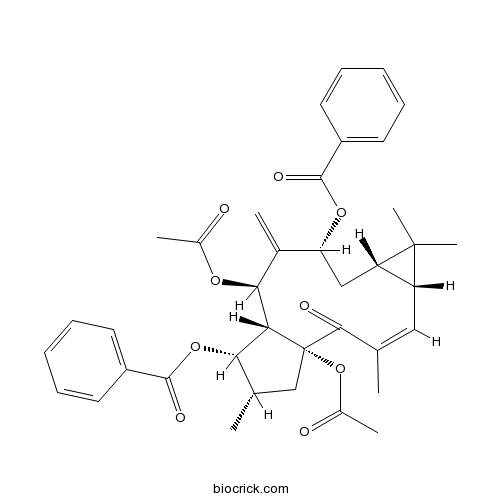Euphorbia factor L2CAS# 218916-51-9 |

Quality Control & MSDS
3D structure
Package In Stock
Number of papers citing our products

| Cas No. | 218916-51-9 | SDF | Download SDF |
| PubChem ID | 101071473 | Appearance | Powder |
| Formula | C38H42O9 | M.Wt | 642.7 |
| Type of Compound | Diterpenoids | Storage | Desiccate at -20°C |
| Solubility | Soluble in Chloroform,Dichloromethane,Ethyl Acetate,DMSO,Acetone,etc. | ||
| Chemical Name | [(1R,3Z,5R,7S,9R,11R,12R,13S,14S)-1,11-diacetyloxy-13-benzoyloxy-3,6,6,14-tetramethyl-10-methylidene-2-oxo-9-tricyclo[10.3.0.05,7]pentadec-3-enyl] benzoate | ||
| SMILES | CC1CC2(C(C1OC(=O)C3=CC=CC=C3)C(C(=C)C(CC4C(C4(C)C)C=C(C2=O)C)OC(=O)C5=CC=CC=C5)OC(=O)C)OC(=O)C | ||
| Standard InChIKey | AFRGWGGHJYMSDU-NKGNXCQNSA-N | ||
| Standard InChI | InChI=1S/C38H42O9/c1-21-18-28-29(37(28,6)7)19-30(45-35(42)26-14-10-8-11-15-26)23(3)33(44-24(4)39)31-32(46-36(43)27-16-12-9-13-17-27)22(2)20-38(31,34(21)41)47-25(5)40/h8-18,22,28-33H,3,19-20H2,1-2,4-7H3/b21-18-/t22-,28+,29-,30+,31+,32-,33-,38+/m0/s1 | ||
| General tips | For obtaining a higher solubility , please warm the tube at 37 ℃ and shake it in the ultrasonic bath for a while.Stock solution can be stored below -20℃ for several months. We recommend that you prepare and use the solution on the same day. However, if the test schedule requires, the stock solutions can be prepared in advance, and the stock solution must be sealed and stored below -20℃. In general, the stock solution can be kept for several months. Before use, we recommend that you leave the vial at room temperature for at least an hour before opening it. |
||
| About Packaging | 1. The packaging of the product may be reversed during transportation, cause the high purity compounds to adhere to the neck or cap of the vial.Take the vail out of its packaging and shake gently until the compounds fall to the bottom of the vial. 2. For liquid products, please centrifuge at 500xg to gather the liquid to the bottom of the vial. 3. Try to avoid loss or contamination during the experiment. |
||
| Shipping Condition | Packaging according to customer requirements(5mg, 10mg, 20mg and more). Ship via FedEx, DHL, UPS, EMS or other couriers with RT, or blue ice upon request. | ||
| Description | 1. Euphorbia factor L2 shows cytotoxic activity against lung carcinoma A549 cells, it induces apoptosis through a mitochondrial pathway. |
| Targets | ROS | Caspase | PARP | P450 (e.g. CYP17) |

Euphorbia factor L2 Dilution Calculator

Euphorbia factor L2 Molarity Calculator
| 1 mg | 5 mg | 10 mg | 20 mg | 25 mg | |
| 1 mM | 1.5559 mL | 7.7797 mL | 15.5594 mL | 31.1187 mL | 38.8984 mL |
| 5 mM | 0.3112 mL | 1.5559 mL | 3.1119 mL | 6.2237 mL | 7.7797 mL |
| 10 mM | 0.1556 mL | 0.778 mL | 1.5559 mL | 3.1119 mL | 3.8898 mL |
| 50 mM | 0.0311 mL | 0.1556 mL | 0.3112 mL | 0.6224 mL | 0.778 mL |
| 100 mM | 0.0156 mL | 0.0778 mL | 0.1556 mL | 0.3112 mL | 0.389 mL |
| * Note: If you are in the process of experiment, it's necessary to make the dilution ratios of the samples. The dilution data above is only for reference. Normally, it's can get a better solubility within lower of Concentrations. | |||||

Calcutta University

University of Minnesota

University of Maryland School of Medicine

University of Illinois at Chicago

The Ohio State University

University of Zurich

Harvard University

Colorado State University

Auburn University

Yale University

Worcester Polytechnic Institute

Washington State University

Stanford University

University of Leipzig

Universidade da Beira Interior

The Institute of Cancer Research

Heidelberg University

University of Amsterdam

University of Auckland

TsingHua University

The University of Michigan

Miami University

DRURY University

Jilin University

Fudan University

Wuhan University

Sun Yat-sen University

Universite de Paris

Deemed University

Auckland University

The University of Tokyo

Korea University
- Ciwujiatone
Catalog No.:BCN7598
CAS No.:218901-26-9
- Taraxeryl acetate
Catalog No.:BCN4937
CAS No.:2189-80-2
- 1-Phenyloctane
Catalog No.:BCN2227
CAS No.:2189-60-8
- Boc-Orn-OH
Catalog No.:BCC3427
CAS No.:21887-64-9
- Horminone
Catalog No.:BCN4936
CAS No.:21887-01-4
- Lycorine chloride
Catalog No.:BCN1220
CAS No.:2188-68-3
- Boc-Arg(NO2)-OH
Catalog No.:BCC3065
CAS No.:2188-18-3
- 12-Hydroxyisodrimenin
Catalog No.:BCN4935
CAS No.:218780-16-6
- Boc- ß-HoIle-OH
Catalog No.:BCC3236
CAS No.:218608-82-3
- Bardoxolone methyl
Catalog No.:BCC1400
CAS No.:218600-53-4
- Bardoxolone
Catalog No.:BCC1399
CAS No.:218600-44-3
- Falcarinol
Catalog No.:BCN3938
CAS No.:21852-80-2
- 5,15-Diacetyl-3-benzoyllathyrol
Catalog No.:BCN1196
CAS No.:218916-52-0
- Euphorbia factor L8
Catalog No.:BCN3785
CAS No.:218916-53-1
- KNK437
Catalog No.:BCC6399
CAS No.:218924-25-5
- Z-Trp(Boc)-OH.DCHA
Catalog No.:BCC2749
CAS No.:218938-57-9
- Boc-ß-HoGlu(OBzl)-OH
Catalog No.:BCC3233
CAS No.:218943-30-7
- 2,3-Dihydro-3-methoxywithaferin A
Catalog No.:BCN7943
CAS No.:21902-96-5
- 3'-Methoxydaidzein
Catalog No.:BCN4082
CAS No.:21913-98-4
- Ac-YVAD-AFC
Catalog No.:BCC4022
CAS No.:219137-85-6
- Hydroxyzine 2HCl
Catalog No.:BCC4519
CAS No.:2192-20-3
- 2-Hydroxy-3,4,5,6-tetramethoxychalcone
Catalog No.:BCN1489
CAS No.:219298-74-5
- H-ß-HoIle-OH.HCl
Catalog No.:BCC3235
CAS No.:219310-10-8
- Boc-Nle-OH.DCHA
Catalog No.:BCC3297
CAS No.:21947-32-0
Euphorbia factor L2 induces apoptosis in A549 cells through the mitochondrial pathway.[Pubmed:28119809]
Acta Pharm Sin B. 2017 Jan;7(1):59-64.
Euphorbia factor L2, a lathyrane diterpenoid isolated from caper euphorbia seed (the seeds of Euphorbia lathyris L.), has been traditionally applied to treat cancer. This article focuses on the cytotoxic activity of Euphorbia factor L2 against lung carcinoma A549 cells and the mechanism by which apoptosis is induced. We analyzed the cytotoxicity and related mechanism of Euphorbia factor L2 with an MTT assay, an annexin V-FITC/PI test, a colorimetric assay, and immunoblotting. Euphorbia factor L2 showed potent cytotoxicity to A549 cells. Euphorbia factor L2 led to an increase in reactive oxygen species (ROS) generation, a loss of mitochondrial electrochemical potential, release of cytochrome c, activation of caspase-9 and caspase-3, and cleavage of poly(ADP-ribose) polymerase, suggesting that Euphorbia factor L2 induced apoptosis through a mitochondrial pathway. The cytotoxic activity of Euphorbia factor L2 in A549 cells and the related mechanisms of apoptotic induction provide support for the further investigation of caper euphorbia seeds.


